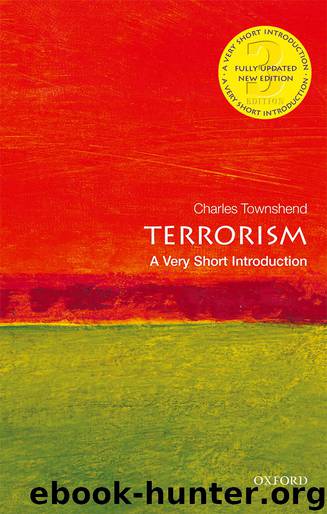Terrorism by Charles Townshend

Author:Charles Townshend
Language: eng
Format: epub
ISBN: 9780192536778
Publisher: Oxford University Press
Published: 2018-04-04T00:00:00+00:00
The case of Irish republicanism
The longest-lived of them, so far, is the Irish republican movement, whose most recent armed campaign lasted thirty years, and which can confidently trace its ancestry back another century. And though tactics have varied over time, the IRA (see Chapter 1), whether Official, Provisional, Continuity, or Real, still follows the operating logic laid down by the Irish Revolutionary Brotherhood in the 1850s. In terms of organization and method, the continuity may be thought to stretch yet further back, into the agrarian terrorism of the Catholic ‘Defenders’ of the 18th century. (Though whether these represented the Irish nation is still a sensitive political question.) It is worth pondering the reasons for this almost unblinking commitment to the use of political violence.
The original ‘physical force’ movement, the Irish Republican Brotherhood (IRB; colloquially known as the Fenians; ‘the Organization’ to its members) began life around 1858 as a classical insurrectionist group, believing that a small armed vanguard could energize and lead the people in open rebellion. It faced two primary difficulties: first, organizing in secret to avoid police surveillance; and, second, choosing the critical moment to raise the flag of revolt. The imperative of security impelled them to follow the organizational pattern of continental freemasonry, with a sequence of carefully controlled levels of initiation. This, ironically, made them resemble the oath-bound agrarian secret societies like ‘Captain Moonlight’ which fought for control of the land in Ireland, a struggle which the Fenians themselves rejected as debasing the cause of national independence. Oath-bound secrecy also led them to fall foul of the Catholic Church, which condemned them as free-thinking subversives. Their biggest problem, though, was that a secret organization could do little to prepare the people for the insurrectionary moment. It had to trust that the innate (as it hoped) popular desire for national independence would be ignited by the spark of armed action, and impel the masses to rise up against the government. This did not happen—in Ireland, in Italy, or anywhere else that insurrectionist groups patiently organized and waited.
The republican shift to terrorism, which might be thought inevitable from a 20th-century perspective, was surprisingly hesitant and contested. The failure of ‘military’ Fenianism—the apparently promising idea of infiltrating the Irish regiments of the British Army to turn their rank and file against Britain—in 1864–6 was followed by a ‘spectacular’ action, the 1867 Clerkenwell explosion, which may be seen as the world’s first urban bombing. But it was accidental, and was not repeated. The leaders of the Fenian organization in Ireland, committed to the concept of ‘honourable warfare’, associated terrorism with the murky activities of the agrarian secret societies. Yet the Clerkenwell explosion had a far bigger impact on British politics than any of the IRB’s ‘honourable’ military efforts. It led to two major reforms, launched by Gladstone in 1868 under the banner of ‘pacifying Ireland’. The IRB Supreme Council was unmoved by these achievements, though, judging them irrelevant, or even damaging, to the struggle for national liberation.
Other Irish republicans were less fastidious.
Download
This site does not store any files on its server. We only index and link to content provided by other sites. Please contact the content providers to delete copyright contents if any and email us, we'll remove relevant links or contents immediately.
| Arms Control | Diplomacy |
| Security | Trades & Tariffs |
| Treaties | African |
| Asian | Australian & Oceanian |
| Canadian | Caribbean & Latin American |
| European | Middle Eastern |
| Russian & Former Soviet Union |
The Secret History by Donna Tartt(16623)
The Social Justice Warrior Handbook by Lisa De Pasquale(11489)
Thirteen Reasons Why by Jay Asher(7788)
This Is How You Lose Her by Junot Diaz(5772)
Weapons of Math Destruction by Cathy O'Neil(5037)
Zero to One by Peter Thiel(4824)
The Myth of the Strong Leader by Archie Brown(4789)
Promise Me, Dad by Joe Biden(4447)
Beartown by Fredrik Backman(4419)
Stone's Rules by Roger Stone(4415)
How Democracies Die by Steven Levitsky & Daniel Ziblatt(4399)
The Fire Next Time by James Baldwin(4343)
100 Deadly Skills by Clint Emerson(4079)
A Higher Loyalty: Truth, Lies, and Leadership by James Comey(4033)
Rise and Kill First by Ronen Bergman(4012)
The David Icke Guide to the Global Conspiracy (and how to end it) by David Icke(3882)
The Farm by Tom Rob Smith(3872)
Secrecy World by Jake Bernstein(3782)
The Doomsday Machine by Daniel Ellsberg(3731)
